A host of companies that utilize real-time video in their business model or business communications will be facing a similar question this year: what alternatives do I have for replacing Twilio Video before it reaches its end of life? It is a good question and one that should be carefully researched. A major migration like this is not a small task and there are many details to consider.
You may be surprised to learn that many of the alternatives to Twilio Programmable Video do not fall under the same CPaaS (Commercial Platform as a Service) category. Today, we’ll explore open source media servers and whether you should consider this type of WebRTC architecture as a replacement for Twilio Video.
Let’s begin with some simple definitions before diving into when and why to consider an open source media server as a replacement for your Twilio application, or any WebRTC application, for that matter.
Remind me again why I need a media server?
The APIs that enable Web Real-time Communication are the GetUserMedia API, RTCPeerConnection API, and RTCDataChannel API. If your connection is just between two users (a.k.a. peers), this is all you need. However, when enabling video, voice, or data communication with groups, or to build in additional features like recording or ML integrations, you need an intermediary.
In WebRTC, the media server handles the many functionalities required to enable video, audio, and data exchange between web browsers. These include:
- Signaling
- Media Processing
- NAT Traversal
- Packet Routing
- Implementing encryption and security measures
For more on these concepts, check out our WebRTC Developer Advocate’s excellent series on Networking Basics for WebRTC.
Isn’t that what a CPaaS does?
Yes, a CPaaS handles these functionalities for you. In fact, it’s right there in its name. The ‘C’ and ‘P’ stand for ‘Communication Platform’. This is the infrastructure required to enable communication features in an application. The fact that this is offered ‘As a Service’ means they are taking care of all the complexity inherent in building and maintaining that application. It’s one of the reasons why a CPaaS may be the right choice for your application.
So, why use an open source media server instead?
Open source media servers will handle some of the same details for you as a CPaaS will, or at least abstract some of that complexity away from you. Open source media servers will handle:
- Video/audio details
- Part or all of the WebRTC signaling process
- Possibly STUN/TURN
- Some scaling capabilities
- Could be SFUs or MCUs
- browser/mobile support
And best of all, it’s free*
There is no licensing cost to use an open source media server. Ongoing transactional fees will also be considerably lower than a CPaaS because your transactional costs are based on cloud server usage and bandwidth, rather than the pricing model of a CPaaS which typically charges a larger transaction fee per connection.
However, it requires a higher capital expenditure at the beginning to build it, as well as ongoing DevOps work. With an open source WebRTC media server, you are responsible for:
- All infrastructure/devops
- Any scaling of the architecture infrastructure in the cloud
- Structural updates
- Media server updates
Is an open source media server right for your existing Twilio app?
It may be, if you can check off the items in this list:
- Your business model is based on a lot of low cost or free WebRTC conversations where the transactional costs of a traditional CPaaS are prohibitive
- You have a decent budget for upfront development
- You are not in a huge rush to market and can take the time to build an elegant infrastructure that will scale with you
- You have a technical team that is comfortable managing the infrastructure. Or, you have the means to contract with one (PSA: we do offer Managed Services, in addition to our development work and other services.)
- Your team would benefit from the support of open source communities around the media server you choose, and you are comfortable with community driven support rather than CPaaS enterprise support SLAs. Even better, you are willing to contribute back to that community and improve the project you work with!
Don’t forget about features
Many open source media servers boast robust feature sets, comparable to or even exceeding some CPaaS alternatives, including advanced media processing capabilities and support for diverse codecs. This will be part of the analysis in my next post, Which Open Source Media Server Is Right For You?
Whatever you do, don’t wait too long
As I mentioned at the beginning of this post, switching video communication providers is not a small task and there are many details to consider. Check out our Twilio Migration Guide for a suggested timeline and lots more resources.
And don’t hesitate to call on the experts at WebRTC.ventures for a quote on an assessment package to help make a decision. We can help with the migration, too. Contact us today!
Further reference on this topic:












